What Does a House Wren Look Like?
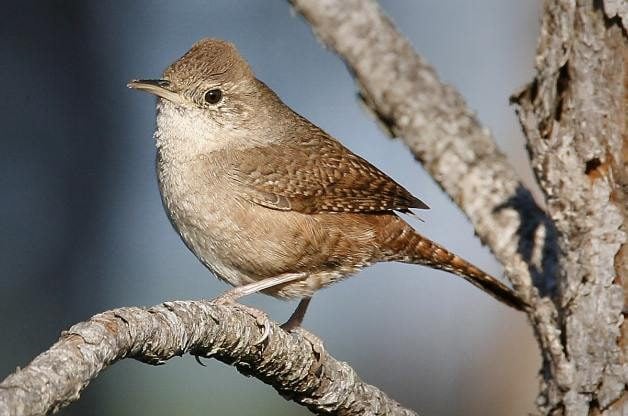
People often describe the house wren as plain because the bird has simple brown colors. But don’t disregard these backyard guests. House wrens measure 4 3/4 inches long with a wingspan of 6 inches. Look for a bird with a brown body and narrow dark bars or stripes on its wings and tail.
Learn how to identify and attract a Carolina wren and a Bewick’s wren. Plus, learn the differences between a house wren and a Carolina wren, and between wrens and sparrows.
House Wren Song
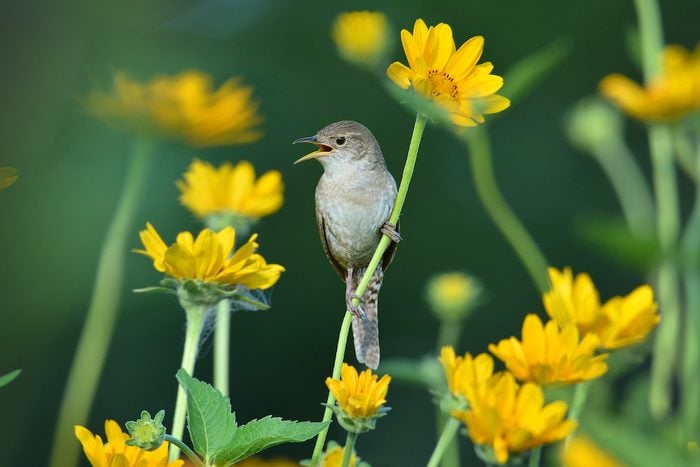
An unstoppable waterfall of notes spills from the throat of the tiny, indefatigable house wren, one of our most beloved backyard birds. What house wrens lack in appearance they make up for with their songs. In fact, it’s not uncommon for male house wrens to sing nine to 11 times per minute during breeding season. The male’s singing is mostly a territorial claim. Wrens often nest close to people, so you’re likely to hear them this spring. Listen for their boisterous melodies during the summer season. Their rapid rolling trill rises and then descends into a bubbling song.
The house wren is the virtuoso, but all wrens have voices that will perk your ears up.
Listen to the house wren’s song.
Bird songs provided by the Cornell Lab of Ornithology.
Enjoy 16 delightful pictures of wren birds.
Nests and Eggs
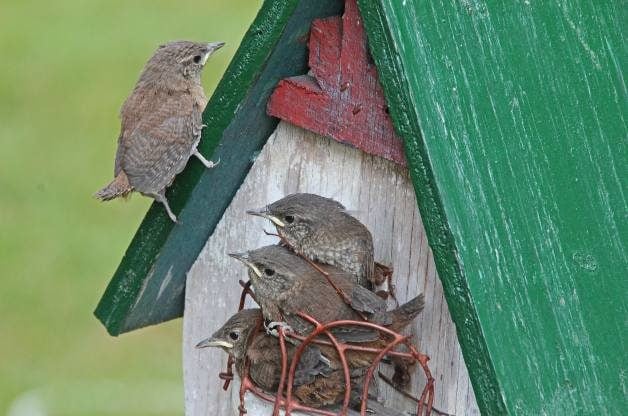
Even though house wrens don’t stop at feeders, they are still a common backyard bird because they’re cavity nesters. They use natural cavities but they also like manmade nest boxes. Create a brush pile and grow plenty of trees and shrubs for them to use for nesting. If you put up a birdhouse with a 1-1/8-inch entrance, you have a good chance of welcoming a house wren family. Chickadees and wrens nest in the same kind of birdhouse. If it says, “wren house,” it will work for both species.
The male is serious about nest-building in spring, because it’s what helps him attract a mate. He starts constructing a few nests at once. His female partner chooses the most promising one, finishes it and mates with the owner.
Head southwest to see a cactus wren.

Six or seven speckled-white eggs are laid in a nest of twigs hidden in a tree cavity or birdhouse. House wrens may lay as many as 10 eggs in one brood. On occasion, the eggs may hatch in only nine days, but 12 is more typical. You’ll know the moment because the babies begin cheeping.
Get more tips to attract nesting Carolina and house wrens.
What Do House Wrens Eat?

Since they mostly eat insects, you won’t see them at feeders much, but they will stop by sometimes for seed and suet. Learn more about how to attract wrens to your yard.
Range Map and Habitat
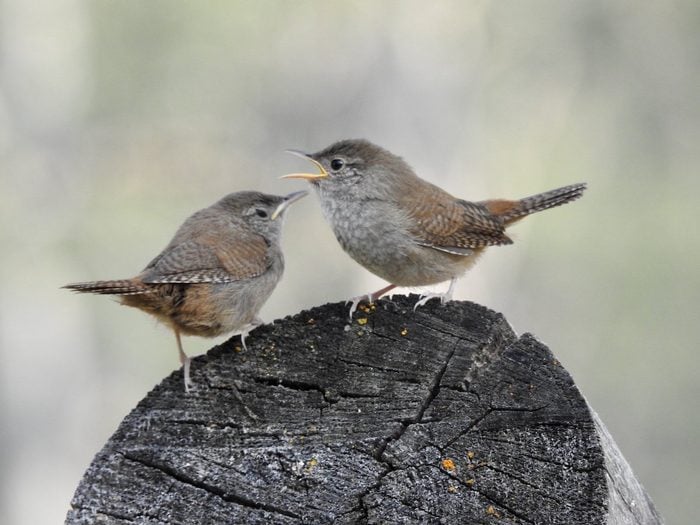
This species is the most common wren in North America, present throughout most of the continent during summer. Look for these wrens foraging for insects in low tree branches, shrubs and brush piles in backyards, parks and open woods. The more places there are for insects to hide, the better the habitat is for house wrens.
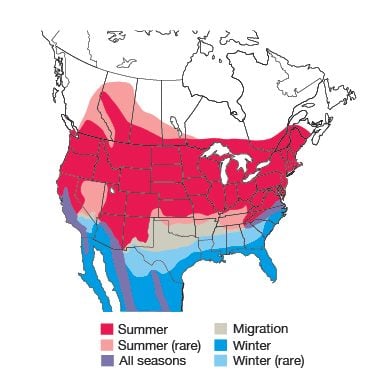
Range maps provided by Kaufman Field Guides, the official field guide of Birds & Blooms.

September brings the end of summer and the beginning of some fall favorites: pumpkin-spice lattes, football season and late-season blooms like morning glories and asters. These two blooms are also known as the September birth flowers.
Here’s everything you need to know about the September birth flowers, including some of the best September floral-inspired gifts to help celebrate your family, friends and coworkers. Who doesn’t love a gift inspired by flowers?
Not celebrating a September birthday? Don’t worry—we’ve got you covered with birth flower gift guides for January, February, March, April, May, June, July, August, October, November and December too.
What Are September’s Birth Flowers?

Those born in the month of September are blessed with two birth flowers—morning glories and asters.
Morning glories have distinct heart-shaped leaves and trumpet-shaped flowers that blossom in colorful sprays of magenta, purple, blue, pink and white. Morning glories typically bloom from early summer to the start of fall, right around September. They’re also one of the fastest-growing annual flowers, which is good news for any procrastinating gardeners. Not only will these speedy blooms add bright pops of color to the garden, they also attract butterflies and hummingbirds.
Late season butterflies and hummingbirds are also attracted to aster flowers—September’s other birth flower. Asters, which bloom in late summer and fall, have star-shaped flowers that resemble daisies. Available in a range of colors, the most common asters available in the U.S. are the New England and New York asters.
Don’t miss these other annual flowers that attract hummingbirds.
What Are the Meanings of September’s Birth Flowers?
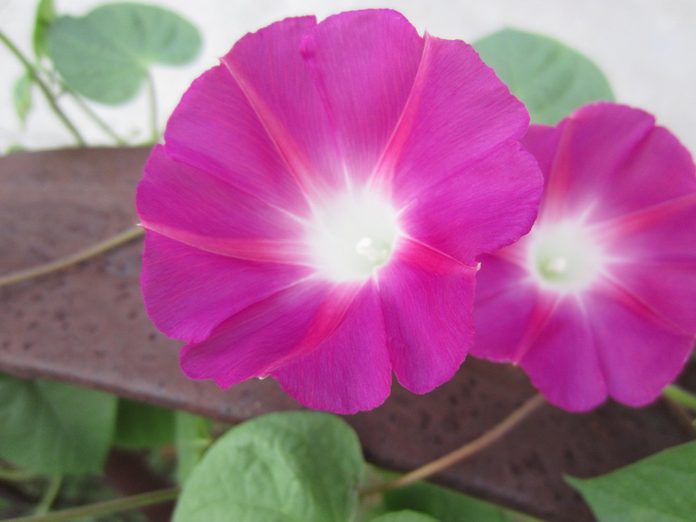
The meaning of both September birth flowers is rooted in love. Morning glories are symbols of love and affection. Aster flowers symbolize love, wisdom and faith. The aster flower’s star-shaped blooms inspired its name. Aster comes from the Ancient Greek word “aster” meaning “star.” Other star-related words, like asteroid and asterisk, are derived from the same word.
Now that you know more about September’s birth flowers, we’ve got the perfect gifts for everyone on your September birthday list—from luxuriously soft robes and custom stationary to flower seeds packs and everything in between.
Love roses? Don’t miss these pretty rose gifts.
September Birth Flower Gift Guide
Aster Flower Robe

This super-soft robe features brightly colored aster flowers that look lovely on anyone. Designed by Juliet Meeks, this robe is made with sustainably sourced, biodegradable material and is available in two sizes for the perfect fit. This robe is also available in other birth month flower prints.
Morning Glory Botanical Art Print

This September birth flower-inspired art print will be enjoyed all year long. This original painting of three bright blue morning glories has been reprinted onto watercolor paper with hand deckled edges. Choose from three sizes.
Recycled Glass Birth Month Flower Vase

The gorgeous colors featured in this handmade recycled glass vase were inspired by the colors of the September birth month flower—the aster. Fill this thoughtful birthday gift with fresh blooms all year long.
Personalized Birth Flower Notepad

Jot down all of life’s important notes on this birth flower notepad illustrated with colorful morning glories and personalized with the name of your choice. This notepad is available lined or unlined in two different sizes. It’ll last longer than a birthday candle!
Morning Glory Seeds

This gift requires a little bit of a green thumb, but the result is totally worth it when these morning glory seeds bloom into a vibrant blue hanging vine. This practical gift idea looks beautiful and will attract butterflies and hummingbirds to your garden.
Birth Flower Glass

Say “cheers” to the start of a happy and healthy new birthday year with these special birth flower glasses. Each one features a digital print of asters, the September birth flower, on the sides of the glass tumbler. We’ll toast to that!
Birth Flower Necklace

Personalize this birth flower necklace with a pendant embossed with an illustration of an aster and a dainty birthstone charm in your choice of gold, rose-gold or silver-tone. Further customize this piece with optional back-side engraving. This necklace ships the next business day for any last-minute birthday shoppers.
Personalized Birth Flower Notebook

Gift this personalized vegan leather notebook to that someone special celebrating a September birthday. Customize the 112-page journal with the birth flower of your choice—available for all months of the year—one of 11 color options and the name of the gift recipient. So thoughtful!
Birth Flower Key Chain

Add some style to their day with a birth flower key chain. Perfect for house, car or office keys, this gold and white enamel keychain is made in the shape of an aster flower. Add an engraved message to the back to make it extra special.
Morning Glory Birth Flower Candle

This September birth-month candle is inspired by morning glory flowers. While the scent is delightful, the packaging is equally as lovely. The glass votive housing the candle wax features an illustration of morning glories, and the exterior packaging includes information about what the morning glory means for September birth days.
Next, check out 20 sunflower gifts that will brighten anyone’s day.
Bird Spring Migration: Where to Go
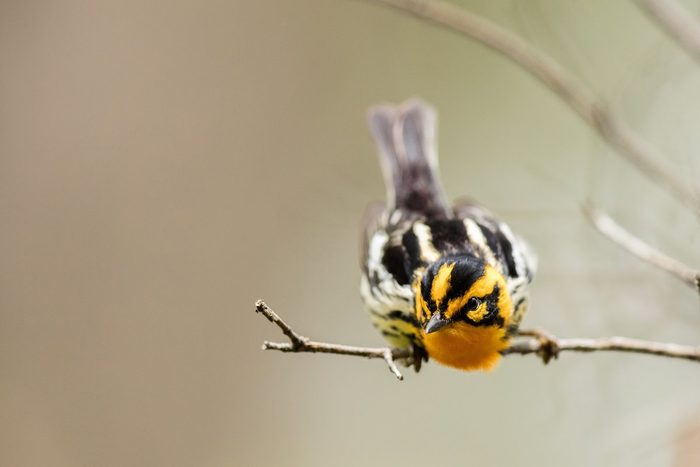
The words bird spring migration are enough to bring a gleam to any birder’s eye. Spring birding is legendary. Birds are flaunting their very best and brightest feather colors as they prepare for mating season. Their journeys take them across hundreds and even thousands of miles, giving birders a chance to see a wider variety of birds. Though migratory birds can (and do) show up anywhere, some spots are better than others. Things that make an outstanding bird spring migration hotspot include:
- Resting places before or after water crossings. Areas on the edges of large lakes, gulfs, bays, or oceans draw migrants as they rest in anticipation of their crossing, or recover from their extended efforts. Some examples include Magee Marsh and Point Pelee on the shores of Lake Erie.
- Stands of trees or water in otherwise open spaces. When birds journey across places like the Great Plains, trees or bodies of water become an immediate draw. The same goes for parks in urban places like Central Park in New York.
- Food and fresh water. When you’re crossing a desert or a large body of salt water, there’s little food and fresh drinking water to be had. That makes places like the Dry Tortugas a real attraction for migrating birds.
We’ve gathered a list of some of the best bird spring migration hotspots across the United States. Before you go, be sure to research any fees or restrictions. Review recent eBird sightings to see what’s been showing up recently. Once you’re there, chat with other birders and find out where the action is. Finally, remember to be considerate to other birders, natural areas, and the birds.
Check out the top warbler hotspots to visit in spring.
Great Lakes and Midwest Bird Migration Hotspots
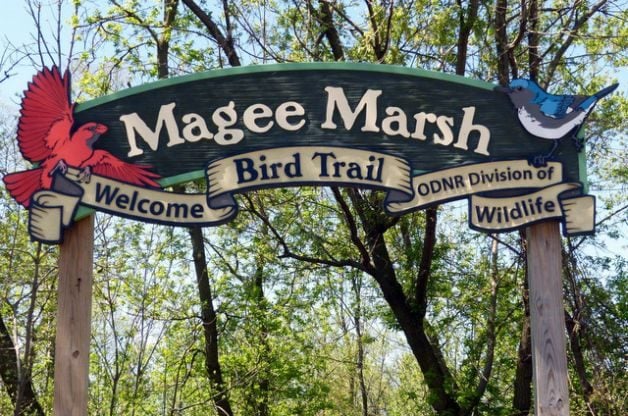
Magee Marsh, Ohio
Magee Marsh along the shores of Lake Erie has become known as the “Warbler Capital of the World” and it’s the site of the Biggest Week in American Birding each May.
Nearby: Ottawa National Wildlife Refuge, Oak Openings Metropark, Pipe Creek Wildlife Area, Sheldon Marsh Preserve
We found more Great Lakes birding hotspots in Michigan, Ohio and Indiana.
Lake Park, Milwaukee, Wisconsin
Birds & Blooms content director Kirsten Schrader says, “Lake Park has super easy walking paths that overlook Lake Michigan, and the spring birding is phenomenal!”
Nearby: Schlitz Audubon Nature Center, Horicon Marsh
Visit Wisconsin waterfalls on a weekend getaway.
Indiana Dunes National Park, Indiana
Birds gather here on the shore of Lake Michigan before continuing on their way north to their breeding grounds in the northern U.S. and Canada.
Nearby: Beverly Shores, Kankakee Sands, Miller Beach
Another lesser known birding hotspot is Goose Pond FWA in Indiana.
Point Pelee, Ontario, Canada

Across Lake Erie from Magee Marsh sits the world-famous Point Pelee. As migrants cross over the lake, this point is one of the first pieces of land that they see, and many of them stop here to feed.
Nearby: Holiday Beach Conservation Area, Rondeau Provincial Park, Pointe Mouillee SGA
Explore 8 must-visit hawk migration hotspots.
Tawas Point State Park, Michigan
Tawas Point offers some of the best birding on Lake Huron. The spot attracts many migrating songbirds in spring.
Nearby: Tuttle Marsh Wildlife Area, Nayanquing Point SWA, Fish Point SWA
Check out coast to coast birding hotspots for every season.
Whitefish Point, Michigan
Whitefish Point is a well-known location for the incredible number of waterbirds that migrate past the point that sticks out into Lake Superior. Thousands of ducks, loons, grebes, geese, and shorebirds pass through each spring.
Nearby: Tahquamenon River Mouth, Seney NWR, Presque Isle Park
Gulf Coast and Southeast Bird Migration Hotspots

High Island, Texas
High Island is one of the most active spring bird migration hotspots on the Gulf coast. The whole High Island area is designed to be birder-friendly and is full of different hotspots.
Nearby: Anahuac NWR, Smith Point, Sabine Woods
Discover the amazing Lower Rio Grande Valley birds.
Dauphin Island, Alabama
Dauphin Island sits just off the the coast of Alabama. It’s one of the first places that migrants make landfall after flying over the Gulf of Mexico from the Yucatan Peninsula in Mexico.
Nearby: Fort Morgan, Grand Bay NWR, Gulf Island National Seashore – Fort Pickens
Check out 33 pictures of warblers that will make you want to go birding.
South Padre Island, Texas
This is the place to go for early migrants, since it’s so far south. The best site on the island is the South Padre Island Convention Center trails.
Nearby: Laguna Atascosa NWR, Hugh Ramsey Park, Boca Chica NWR
Travel to south Texas to see hundreds of rare butterflies.
Dry Tortugas National Park, Florida
Remote Fort Jefferson is an amazing place to be when a fallout occurs. The only fresh water on the entire island is a small well, and since all of the birds need water, the well is the place to be!
Nearby: Fort Zachary Taylor (Key West), Bill Baggs Cape SP, Everglades National Park – Flamingo
Fort De Soto County Park, Florida
The special secret that brings all the birds to this park in spring? Mulberry bushes! The sweet fruit provides the sugar kick migratory birds need after crossing the Gulf of Mexico. The best spot is the fountain and bushes behind the Ranger’s House at East Beach.
Nearby: Sawgrass Lake Park, Lettuce Lake County Park, Circle B Bar Reserve
Don’t miss more of the top Gulf Coast birding hotspots for spring migration.
Northeast and Atlantic Coast Bird Migration Hotspots
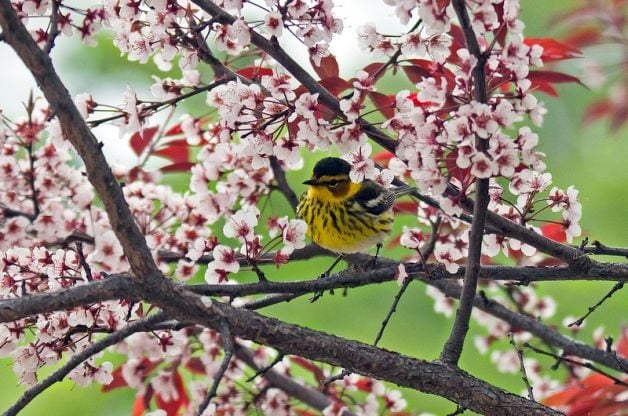
Cape May, New Jersey
When a warbler species is named after an area, you know the birding is good! There are variety of different spots in the area for bird-watching, all with high tallies.
Nearby: Edwin B. Forsythe NWR, Island Beach State Park, Jake’s Landing
Central Park, New York City

The “Central Park Effect” is real. Migratory birds see one oasis of green in a landscape of pavement, and head straight for it. Insiders say climbing Summit Rock near The Ramble is ideal for spotting migrants.
Nearby: Richard W. DeKorte Park, Liberty State Park, Prospect Park
Bombay Hook National Wildlife Refuge, Delaware
On the other side of Delaware Bay from Cape May, NJ, this is another important stop for migratory shorebirds. Go at low tide to see them foraging in the shallows by the thousands.
Nearby: Prime Hook NWR, Little Creek Wildlife Area, Eastern Neck NWR
Plan a big day of birding to see more species.
Monhegan Island, Maine
You’ll need a boat to get to this small island, but the payoff is incredible. Migrants land here later in the season since it’s so far north. During the month of May, the entire island is a migratory birds hotspot.
Nearby: Hog Island, Gilsland Farm Audubon Center, Scarborough Marsh
For more spring bird migration hotspots, follow the Maine Birding Trail
Pea Island NWR, North Carolina
Specially-managed impoundments here support migratory, wintering, and breeding waterfowl. So it’s no surprise that shorebirds like American avocets and piping plovers are a specialty of this locale.
Nearby: Cape Hatteras, Alligator River NWR, Bodie Island Lighthouse & Pond
Do robins migrate and fly south in winter?
West Coast and Southwest Bird Migration Hotspots

Point Reyes National Seashore, California
This national seashore is large and you’ll need several days to really do it justice. It’s a renowned place to see Pacific Flyway migrants, especially on the outer peninsula that projects 10 miles into the ocean.
Nearby: Bodega Bay, Rodeo Lagoon, Hayward Regional Shoreline
Want to get away from the cold? Check out these birding hotspots for snowbirds.
San Pedro RNCA, Arizona
Arizona is known as a birder’s paradise, and the San Pedro valley in spring helps prove that point. In addition to migrants, keep an eye out for area specialties like the elegant trogon.
Nearby: Patagonia Lake State Park, Whitewater Draw, De Anza Trail
Discover the top 5 birding hotspots in Southeast Arizona.
Bosque del Apache NWR, New Mexico
In winter, the thousands of snow geese and sandhill cranes are the draw for birders here. In the spring, as the water dries up, migrating shorebirds take their place, joined by warblers, vireos, and flycatchers.
Nearby: Rio Grande Nature Center, La Joya WMA, Caballo Lake State Park
Learn about 6 bird migration patterns that have changed.
Grays Harbor NWR, Washington
Migrating shorebirds pass through Grays Harbor in enormous numbers each spring. Look for species like red knots, which spend the winter in southern South America, then fly all the way north to the Arctic Circle to breed each year.
Nearby: Ocean Shores, Billy Frank Jr. Nisqually NWR, Pt. Brown Jetty
Discover the best beach birding locations for coastal fliers.
Butterbredt Spring, California
This is the place to go for warbler fans, with more than 20 species regularly spotted during migration in late April to early June. The spring is a little tricky to find for newcomers, so check out these directions first.
Nearby: Kern River County Park, California City Central Park, Kern River Preserve
Meet the desert birds of the Southwest.
Rocky Mountains and Great Plains Migratory Birds Hotspots

Chico Basin Ranch, Colorado
This privately-run ranch charges a small fee for entry, which most birders willingly pay for a chance to check out one of the best places to view migratory birds in the state. Check in at the ranch HQ and then follow the birding trail.
Nearby: Fountain Creek Regional Park, Pueblo Reservoir, Lake Henry
Rowe Sanctuary, Nebraska
The main draw here is the migrating sandhill cranes, which stop to rest and feed in the Platte River in the tens of thousands. This amazing sight takes place from mid-February to April each year.
Nearby: Kirwin NWR, Branched Oak SRA, Pawnee Lake SRA
Cheyenne Bottoms Wildlife Area, Kansas
This 20,000 acre marsh is one of the most important areas in the U.S. for migratory shorebirds like sandpipers and terns. Sandhill cranes also pass through in huge numbers, as well as the occasional whooping crane flock.
Nearby: Quivira NWR, Kanopolis Lake, Wilson Lake
Explore birding hotspots in lesser-known national parks.
Bear River Migratory Bird Refuge, Utah
On the northern end of Great Salt Lake, Bear River is a vital stopover for migrating shorebirds like black-necked stilts. A 12-mile auto loop allows for easy access to the wide array of birding sites in the refuge.
Nearby: Antelope Island SP, Willard Bay, Farmington Bay WMA
Don’t forget about these birding hotspots for incredible winter birds.
Camas National Wildlife Refuge, Idaho
Like many areas in the west, Camas is an ideal place to view migratory shorebirds, but it draws plenty of songbirds passing through as well. The vegetation around the refuge office is an excellent place to start.
Nearby: Market Lake WMA, Mud Lake WMA, Chester Wetlands
Next, check out warbler migration tips for every type of birder.
Grow Garlic With Your Roses
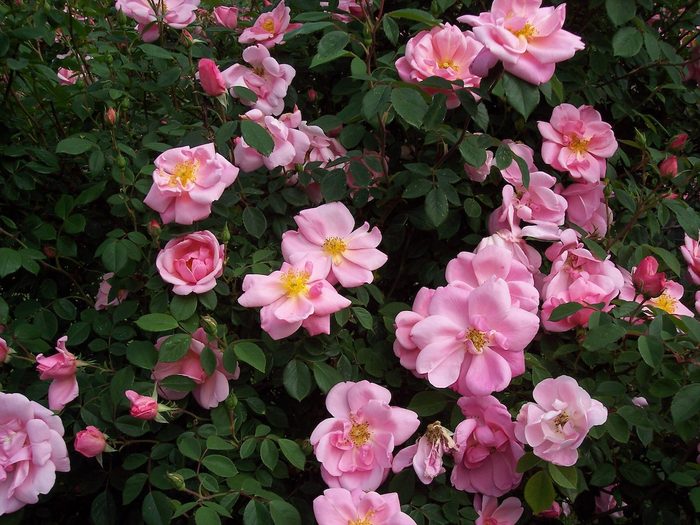
Pairing roses with garlic doesn’t sound like a match made in heaven, does it? But it really is! Garlic protect roses from not only bad bugs—it can also help prevent fungal diseases.
Aphids DON’T love garlic – in fact, they hate it! Ants and snails aren’t huge fans of garlic either. In addition, studies show that garlic has anti-fungal properties, which helps keep fungal diseases like blackspot at bay.
Learn how to prune roses for winter and how to choose the best roses for your garden.
When and How to Plant Garlic
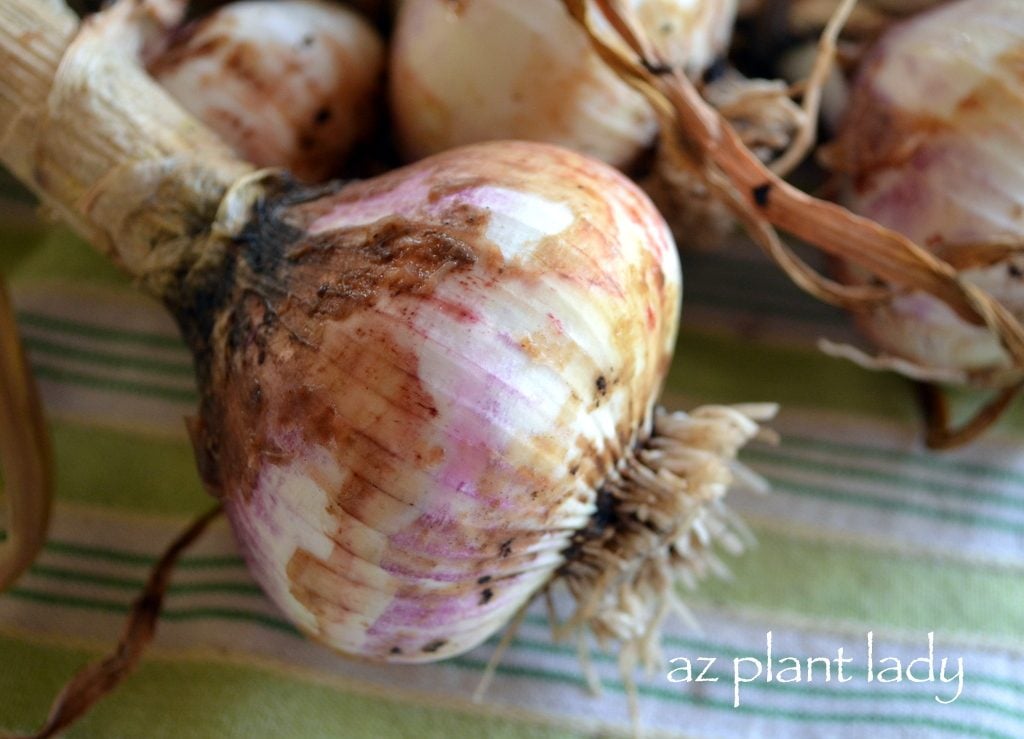
Even if your roses are done blooming for the season, fall is the time to plant garlic next to them. Planting garlic is very easy. You can get your garlic from the produce section at your local grocery store. Roses don’t care about fancy varieties of garlic. Psst—did you know that roses are the June Birth Flower?
Simply separate the the individual cloves and space 4 inches apart, about 1 foot from the base of your rose bush. Dig a 1 1/2 inch deep hole (I use a regular spoon for this) and plant the cloves with the pointed part pointing upward. That’s it! I told you it was easy.
This Rugosa rose deserves lots of love. Plus, learn about Knock Out roses — a gardener’s dream come true.
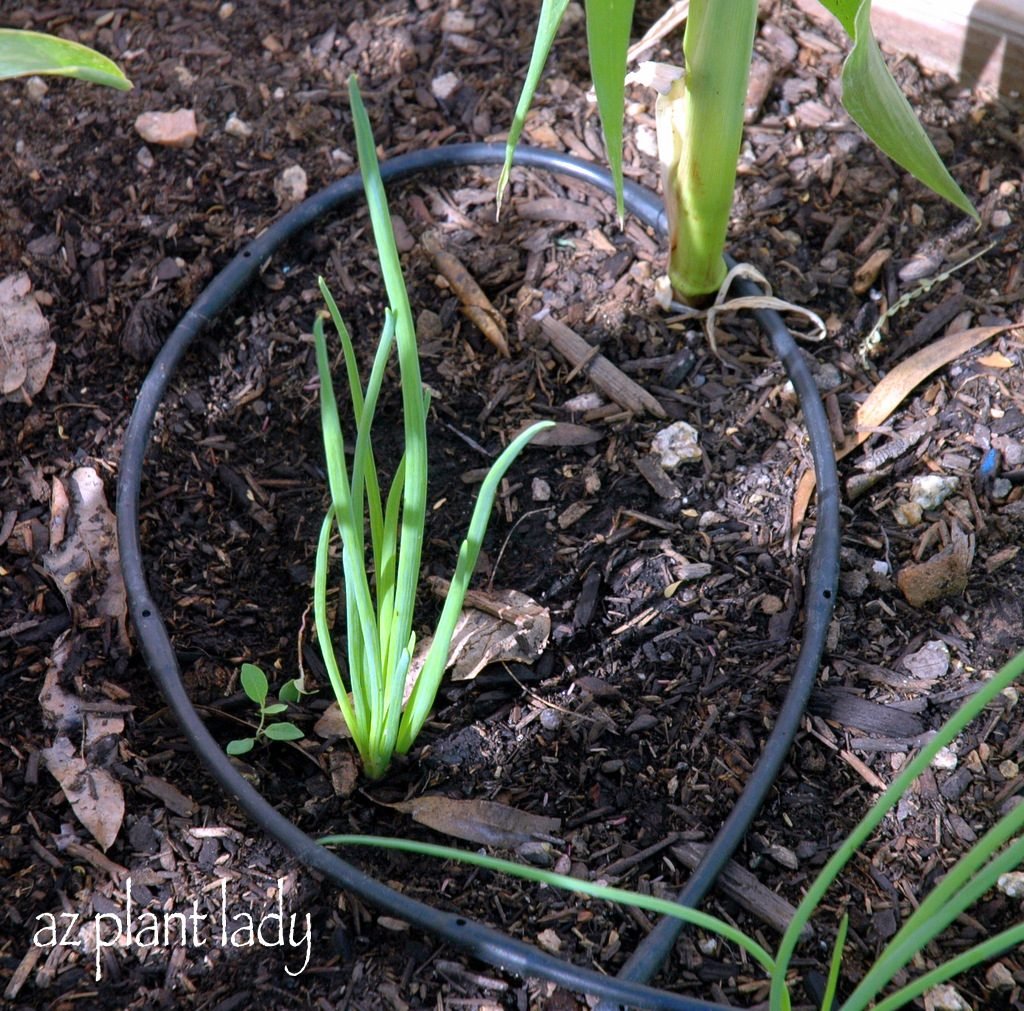
Soon your garlic will send up green shoots. The shoots will stay green in warm-winter areas and die back to the ground in cold areas. Don’t worry, the cloves will quickly send up new shoots in spring.
‘Citrus Splash’ is the gorgeous multicolored rose you need in your garden.
How to Harvest Garlic

Harvest your garlic in late spring or summer once the green leaves start to turn brown. You can even use the garlic for cooking after it has ‘cured’ (or hung up and dried) for a few weeks. Note: Only use your homegrown garlic for cooking as long as you have NOT treated your roses with any pesticides (other then insecticidal soap, which is OK).
We found 15 pretty rose gifts for rose lovers.
Benefits of Growing Garlic and Roses Together
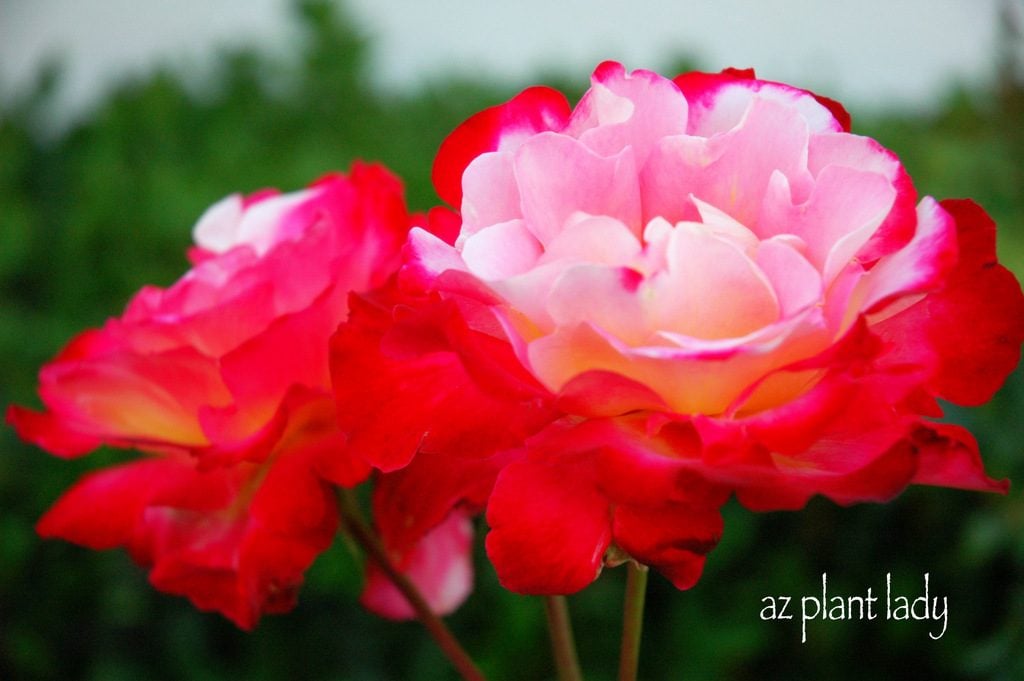
Besides helping to keep aphids away, and fungal diseases away, garlic is said to increase the fragrance of roses, according to The Herb Society of America. That might sound counterintuitive because garlic is known for its strong scent but it’s worth a try!
So, next time you head out to the grocery store, grab some garlic and plant the cloves around your roses. These plants really are the perfect match.
Next, discover 8 surprising facts about roses.
Best Sunflower Varieties to Grow
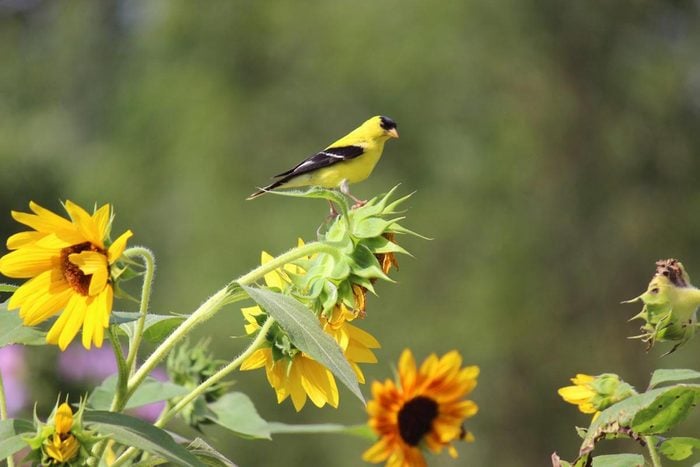
I’ve never met a sunflower I didn’t like. They’re just so darn cheery and happy—no wonder they’re the go-to seed for kids to grow. If you share my love for these big beauties even a little bit, then it’s time to start branching out. Sure, the bright yellow blooms that produce seeds for the birds are classics, but there are so many more options on the market. It’s easy to get overwhelmed by all those cultivars, though, so we’re here to help. Start with this list of some of our favorite sunflower varieties.
Enjoy these sunflower pictures that radiate beauty.
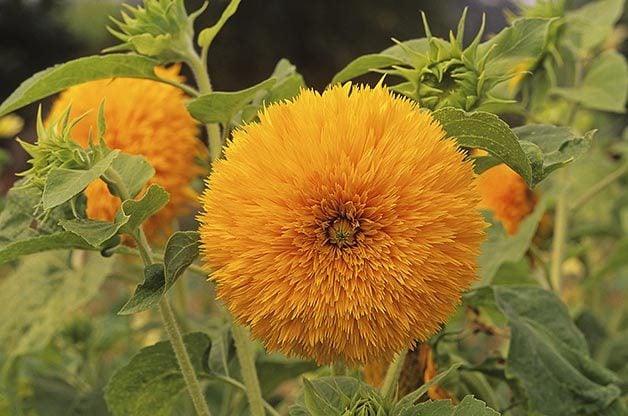
Best Double Bloomer: Giant Sungold
The Teddy Bear cultivar first made double-blooming sunflowers popular—and now you can find even more double sunflower varieties, including our top pick, Giant Sungold. This plant can easily top 6 feet, while the big puffy blooms grow up to 8 inches wide.
Runner-up: Golden Cheer—which works the shaggy, unkempt look in the best way possible—is a very close second.
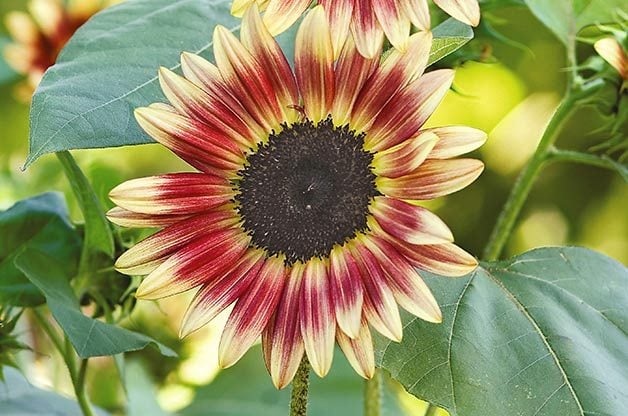
Multicolored: Strawberry Blonde
You’ll do a double take when you see that the petals are rose-pink at the base, while the ends seem to have been dipped in yellow paint. Like most sunflower varieties, Strawberry Blonde grows best in a sunny spot with well-draining soil. This cultivar can grow more than 6 feet high.
Runner-up: Ring of Fire is like an edgier, darker version of Strawberry Blonde. It was also an All-American Selection Winner in 2001.
Backyard birds love black oil sunflower seeds.
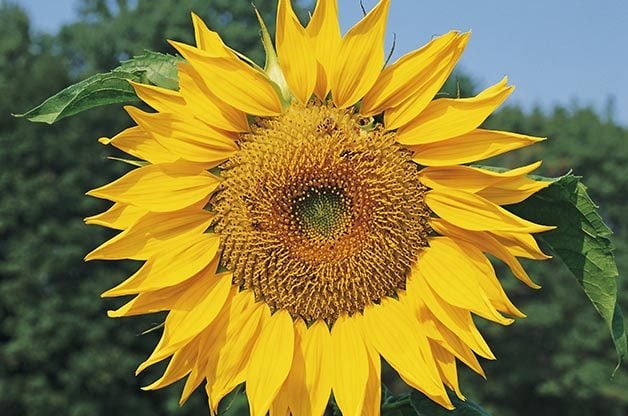
Best Mammoth: Mammoth Russian
Burpee Home Gardens says if you want to enter a sunflower competition at a fair, this is the one to plant. Mammoth Russian grows a whopping 9 to 12 feet tall and produces large striped seeds.
Runner-up: Mammoth Grey Stripe grows 8 to 12 feet tall, with seedheads that are a foot across. Start your seeds early, because they need about 110 days to bloom fully.
Did you know: Tomatoes make great sunflower companion plants.

Best Light Bloomer: Italian White
You won’t find a more gorgeous or reliable light bloomer. Italian White has a top-notch reputation for dependable 4-inch white blooms with chocolate centers. The plants reach 5 to 7 feet and are known for producing lots of flowers over the course of the season.
Runner-up: Coconut Ice is a newer variety, with petals starting out creamy and then gradually getting lighter and brighter.
Learn how to choose sunflower seeds for birds.
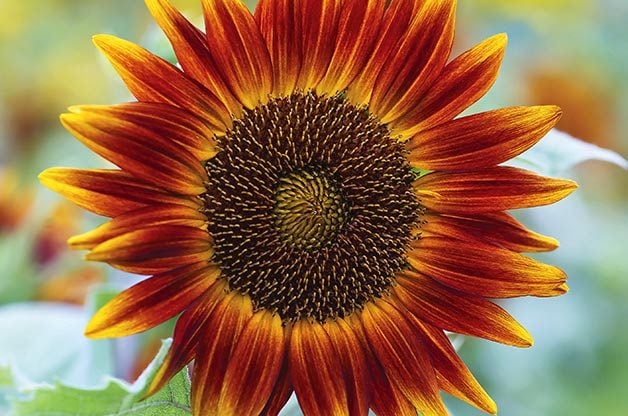
Dwarf Variety: Little Becka
Whether you lack space or just like smaller plants, this one should be on your list. At just 3 feet tall, Little Becka packs a big punch, with lots of 6-inch flowers in a unique color sequence: from gold to crimson and then back to gold again.
Runner-up: Want to go even smaller? Sunny Smile will reach only 12 to 15 inches in height, making it perfect for containers and patios.
Grow Mexican sunflower in pollinator gardens.

Best Dark Bloomer: Moulin Rouge
Do you like dark, bold sunflowers? This one delivers. You can find other red variations, but Moulin Rouge is the most reliable of the bunch. It grows to about 4 feet tall.
Runner-up: With slightly darker, richer hues than Moulin Rouge, Chocolate Cherry is another strong choice and the name says it all.
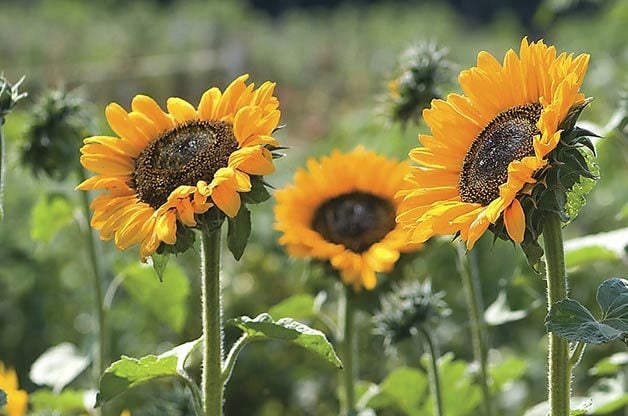
Award Winner: Soraya
In 2000, the Soraya cultivar made history when it became the first sunflower chosen as an All-America Selections winner. It boasts stunning blooms on sturdy stems, so you don’t have to worry about them falling over. It grows up to 6 feet tall and is a pretty cut flower as well.
Runner-up: Another All-America Selections winner, Suntastic, can get up to 20 blooms on a single plant.
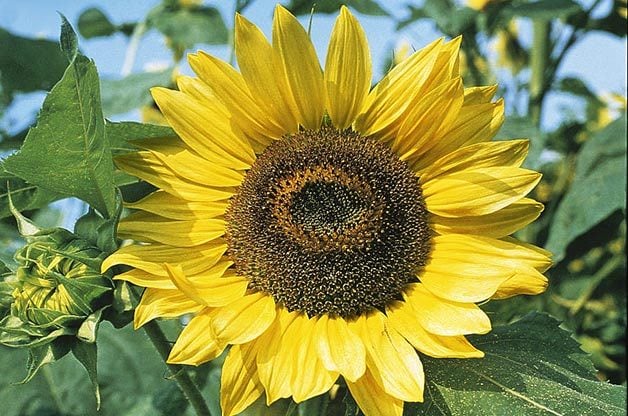
Best for Pollinators: Lemon Queen
Go online right now to greatsunflower.org and check out the Great Sunflower Project. This group counts pollinators visiting plants, which helps with conservation and plant science. Joining up requires you to plant the No. 1 pollinator around, the Lemon Queen sunflower. We hope you’ll sign up to help with the project, but even if you don’t, please plant Lemon Queen to support the bee population. As you may have read, bees urgently need our help to survive and keep pollinating plants.
Runner-up: Take your pick! Most sunflowers are good for bees, as long as you remember not to pick a pollen-free variety.
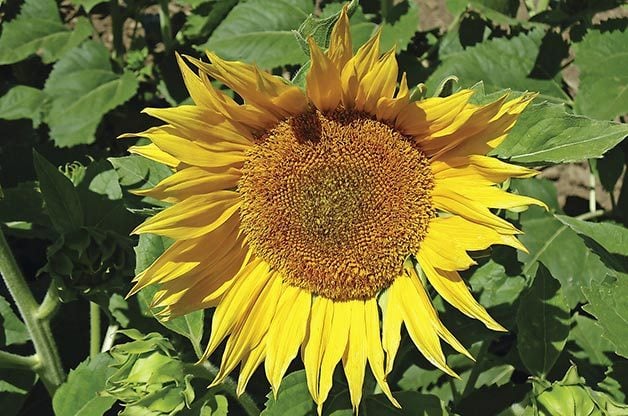
Best Sunflower to Eat: Super Snack Mix
Growing sunflowers mostly for seed, either for the birds or to munch on yourself? The name says it all for this cultivar. Its originators claim to offer the largest seeds around—and they’re easy to crack, too. Super Snack Mix is a classic sunflower that grows up to 6 feet and will also attract bees and butterflies.
Runner-up: Royal Hybrid is also known for its prolific seed. Remember to let the seedheads dry completely before harvesting.
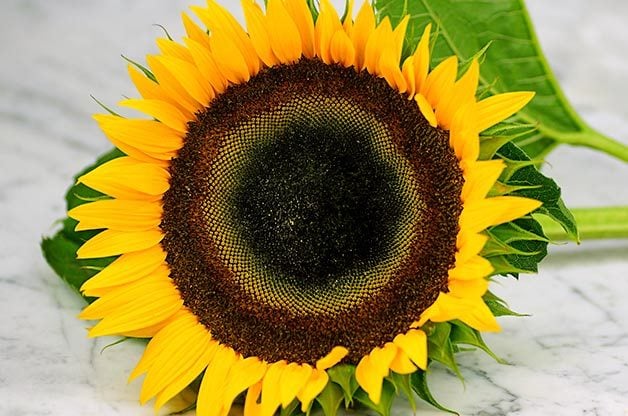
Best Cut Flower: Taiyo Sunflower
You know those perfect-looking sunflowers you see at grocery stores and flower shops? Chances are they’re Taiyos, but you can grow your own cut flowers instead of buying them. These Japanese heirlooms grow 5 to 6 feet tall and have large flower heads with huge centers.
Runner-up: Look for any pollen-free flower to grow for bouquets: It won’t make a mess when you bring it indoors (though keep in mind, as mentioned above, that it won’t benefit bees, either).

Use Epsom Salt for Big Garden Yields
To grow huge flowers (and lots of veggies), I use Epsom salt for my garden. Mix 6 tablespoons Epsom salts and 6 tablespoons Miracle-Gro fertilizer in the hand sprayer attached to my garden hose, says Birds & Blooms reader Juanita Scalia.
Discover 6 ways to use baking soda in the garden, and 7 ways to use eggshells in your garden, too.
Water Potted Plants
Mix 1 tablespoon Epsom salts in a gallon of water for watering container plants, says Therese Barry.
Check out 25 secret garden tips we learned from grandma.
Use Epsom Salt for the Rose Garden
Scratch 1/2 cup of Epsom salts into the soil around each rose bush in spring, Garlic planted around roses is also a great way to keep pests away, says Linda Canfield.
Psst—we found genius garden hacks you’ll want to steal immediately.
Add to Epsom Salt When Planting Bulbs
Add a pinch of Epsom salts to the hole when planting bulbs. It helps the bulbs get started and keeps squirrels and moles from digging them up, says Joan Eiffes.

Grow Bigger Tomatoes
Epsom salts can be used to provide magnesium sulfate to tomatoes, which increases yield and size. Mix 2 tablespoons Epsom salts in 1 gallon of water and apply 1 pint to each plant when blooming begins, says Sandy Traster.
Follow these tomato growing tips for the ultimate crop.
Jump-Start Your Pepper Plants
To boost production of green pepper plants, I sprinkle them with an Epsom salt solution soon after planting. Mix 3 to 4 tablespoons in a gallon of water. Continue sprinkling until the peppers set, says Marilyn Brusven.
Check out 15 ways to conserve water in the garden.
Pest-Free Root Crops
When planting root crops like radishes, turnips and onions, sprinkle Epsom salts over the area to be planted, and you won’t be bothered with bugs, says Wallace Shelby.
Don’t make these 5 common mistakes in the vegetable garden.
Sweeten Melons
Epsom salts and borax can sweeten cantaloupes. Mix 7 tablespoons Epsom salts and 4 tablespoons borax in 5 gallons of water. Spray when the plants begin to vine and again when the cantaloupes are baseball sized, says David Van Ness.
Stop Tomatoes From Splitting
To prevent tomatoes from splitting, dig a hole about 6 inches from the plant, 4 to 6 inches deep. Pour in 1 tablespoon of Epsom salt, cover with dirt and thoroughly water. Since doing this, we no longer have tomatoes that split, says Brenda Trumps-Robinson.
Should you use coffee frounds in the garden?
Keep Bugs Off Flowers
This recipe keeps pests off my flowers. Mix 1 cup Epsom salts, 1/4 cup Ivory liquid soap, 2 tablespoons liquid fertilizer and 5 gallons of water. I put it in a watering can and sprinkle it on, says Evelyn Quigley.
Check out 10 natural ways to eliminate garden insect pests.
Bonus: Easy Garden Gift Idea
Homemade bath salts are easy. Mix Epsom salt with dried herbs like chamomile, lavender or rosemary. Add a few drops of food coloring to get the desired color and then pour the mix into decorative jars. Kids can help with this fun project, and the jars are perfect for teacher gifts, says Darcy Larum.

Clean a Bird Feeder
One of the best ways to use baking soda in the garden is to clean your bird bath. “Shake baking soda into the basin. It removes mold easily and is safe for birds,” says Birds & Blooms reader Stephen Holland. “Cleaning the bird bath isn’t my favorite task, but it’s more fun when you use baking soda and white vinegar. The foam reaction is neat to watch and makes cleaning easy,” says Sharon Erdt.
Learn how (and how often) to clean bird feeders.
Prevent Black Spot on Roses
“To wipe out black spot on your roses, use the following recipe. Combine 1 tablespoons of baking soda, 2 1/2 tablespoons of horticultural oil and 1 gallon of water. Spray this solution on roses once when the symptoms appear and every 1-2 weeks thereafter,” says Laura Horning.
Make your own weed killer with vinegar and dish soap. Plus, discover 10 ways to use epsom salt for your garden. You can use eggshells in your garden, too!
Stop Rot on Grapes
“At the very first sign of brown rot, spray your grapes with a solution of 1 tablespoon baking soda and a gallon of water. I’ve never needed to use this spray more than once a season,” says Eli Troyer.
Psst—don’t miss 25 secret garden tips we learned from grandma.
Win the Bug Battle
Here’s a cheap natural way to repel aphids and spider mites. Mix 1/3 cup cooking oil and 1 teaspoon baking soda in a jar. Keep it covered until needed. Combine 2 teaspoons of the mixture with 1 cup water in a sprayer,” says Henryette Marshall.
Learn how to get rid of indoor plant bugs.
Clean a Bird Bath
“Shake baking soda into the basin. It removes mold easily and is safe for birds,” says Stephen Holland of Sandown, New Hampshire.
Follow these tips to conserve water in the garden.
Clean Your Garden Clothes
“A paste of baking soda and water removes perspiration stains and odor when rubbed on a garment before you throw it in your machine. Works great on hard-to-clean polyester knits, too,” says Lavern Wolf.
Learn how to remove grass stains from clothes and shoes.
Do Robins Mate For Life?

Given the sweet stories of swans, cranes, crows and other birds that form lifelong bonds, you might wonder: Do American robins mate for life?
Unfortunately, robin love stories are a little shorter. Like other backyard songbirds, they are often monogamous once they’ve paired up in spring… but they go their separate ways once the family-raising season comes to a close. Thus, robin “relationships” tend to last only a few months out of the year. They’re certainly not paired for life!
Journey North notes that two robins that have been a mated pair before could end up back on the same breeding grounds in spring and thus pair up again. This scenario becomes more likely if they successfully raised young the year before. But in the traditional sense, robins do not remain monogamous.
Psst—If you see a robin bird, here’s what it means.
Unlike hummingbird males, the male robins are good bird dads. They play an active role in both nest-construction and brood-raising. He’ll bring his partner nesting materials to help her build their cup-style nest. He also sings loudly to defend their territory and all the important resources it provides. After the eggs hatch, he sticks around to help her feed the fledglings, and the mated pair may raise three or more broods together in a single season.
How Do Robins Choose Mates?
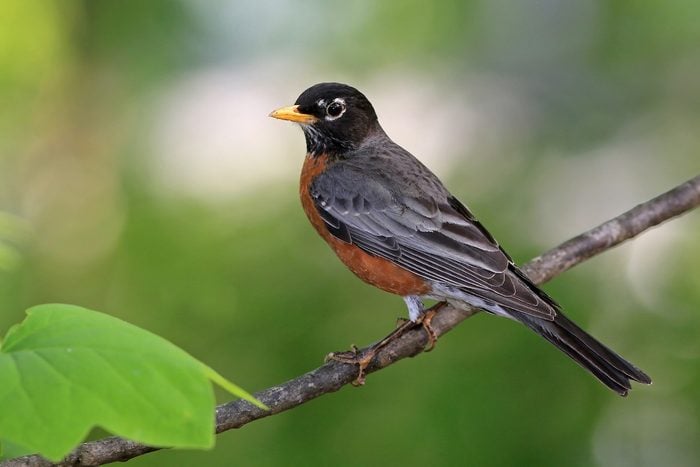
You might be surprised to learn that much of the decision-making in mating comes down to the female robin, rather than the male. Males arrive earlier to the breeding grounds than females, and they spend that extra time claiming and battling for territory. The oldest and strongest robins tend to wind up with the best nesting sites. When they arrive a few weeks later, females select mates based on who has the most eye-catching plumage and the best song.
Will a robin use a bird house?
How Long Do Robins Live?

Unfortunately, these delightful red-breasted birds aren’t long-lived. According to Journey North, most American robins live 5 or 6 years in the wild. But don’t worry, as the total population of American robins has been estimated at 300 million. These adaptable birds are commonly seen in cities, parks, farms and forests across Canada, Alaska and the Lower 48 states. Did you know it’s a myth that robins fly south and return in the spring? Find out what robins eat and learn how to attract them year-round.
What is the Bird Flu?

According to the University of Illinois Extension Office, avian influenza, or the bird flu, is an extremely infectious respiratory disease that affects all domestic poultry, including laying hens, broilers, and turkeys, as well as waterfowl and game birds. It can spread quickly within flocks causing severe disease and death. Currently 33 U.S. states have confirmed avian flu cases in wild birds.
In the last outbreak of bird flu, more than 200 commercial flocks and 21 backyard flocks in the U.S. were affected, leading to the deaths of more than 50 million birds between 2014 and 2015.
Ken Keffer, co-owner of the Wild Birds Unlimited Store in Bloomington, Indiana, says, “Avian flu isn’t new. Avian influenzas were first identified in Europe in the 1870s. Variants of the current highly pathogenic avian influenza strain (HPAI H5N1) first emerged in southern China in 1996. North America had outbreaks in 2014 and 2015. The recent strain was detected in North America last fall, and is different than previous H5N1 viruses according to the Centers for Disease Control.”
Learn more about other common wild bird diseases.
Which Species Are Affected by Bird Flu?

In wild birds, waterfowl including ducks, geese, and swans, are the main group impacted. It can be fatal in these species, although often they carry and transmit the virus without showing symptoms. Other birds including raptors like hawks and eagles, as well as shorebirds and gulls have also tested positive for HPAI H5N1 during this outbreak. Research has shown songbirds are less likely to contract bird flu and are less likely to shed large amounts of the virus. A small number of corvid species (crows, jays, and magpies) have tested positive.
Visible symptoms of bird flu include runny eyes, swelling, and lethargy.
Poultry operations are especially feeling the effects of bird flu. When the disease is detected in domestic poultry, flocks are depopulated to prevent the disease from spreading and removed from the food system. Other area flocks are then monitored for the disease.
Discover 8 ways to ensure a bird-safe backyard.
Is it Safe to Feed Wild Birds Right Now?

There is no official recommendation to take down feeders unless you also keep domestic poultry, according to the National Wildlife Disease Program.
Ken says, “The Cornell Lab of Ornithology and United States Department of Agriculture have both stated that bird feeding is safe. Out of an abundance of caution, some agencies initially suggested taking feeders down, but these guidelines have been scaled back. Currently, I’m not aware of any restrictions in place on bird feeders.”
He further explains if you raise poultry and live in an area where avian influenza is being reported, you could consider removing bird feeders in the short term. “Past outbreaks of avian flu have generally waned by early summer,” he says.
Joy O’Keefe, assistant professor and Illinois Extension wildlife specialist in the Department of Natural Resources & Environmental Sciences, advises homeowners to plant native shrubs and wildflowers this spring for their backyard birds. “In the absence of feeders, birds should be able to find natural sources of food from sprouting native plants and emerging insects,” she says.
The Illinois Department of Natural Resources says hummingbird feeders and oriole feeders do not need to be removed. Check with your state wildlife agency for updated guidelines in your area.
Clean Your Feeders to Reduce the Spread of Disease

Maintaining clean feeders and bird baths is always important. Scrub your feeders clean with some soapy water and a good stiff brush. Then soak them in a 10% bleach solution (1 part bleach to 9 parts water) for a few minutes. Next, rinse them very thoroughly and let them dry completely before putting them back outside. Here’s how to clean a bird bath.
Ken points out it’s also important to maintain a clean area around your feeders. “If you aren’t feeding a no mess blend of seeds without any shells, rake up the empty hulls from under the feeders. You can also consider moving your feeding station around the yard to minimize accumulation,” he says. Try these no mess bird feeders to keep your yard clean.
The USDA has issued biosafety recommendations for backyard poultry flocks. “Poultry owners should keep things as clean as they can,” says Kenneth Koelkebeck, professor and Illinois Extension poultry specialist in the Animal Sciences department. “Remove standing water if possible because it will attract migratory waterfowl.”
Is Bird Flu Dangerous to Humans, Pets or Other Animals?

The CDC is monitoring the recent outbreak and reports it is not an immediate public health concern. In North America, no human cases have been associated with the H5N1 avian flu. The CDC considers the risk of humans catching avian influenza to be low. Similarly, dogs and cats are rarely infected.
However, pet birds and domestic poultry, including backyard chickens, can be susceptible to bird flu. Domestic flock owners should prevent contact between their backyard flocks and wild birds.
What to Do if You See Sick or Dead Birds
Report sick or dead birds to your state wildlife agency or local agricultural extension agent. You can also contact the U.S. Department of Agriculture’s Animal and Plant Health Inspection Service Veterinary Services toll-free at 1-866-536-7593.
Next, find out how to help a bird that flew into a window.